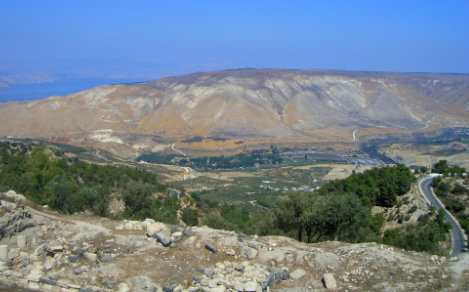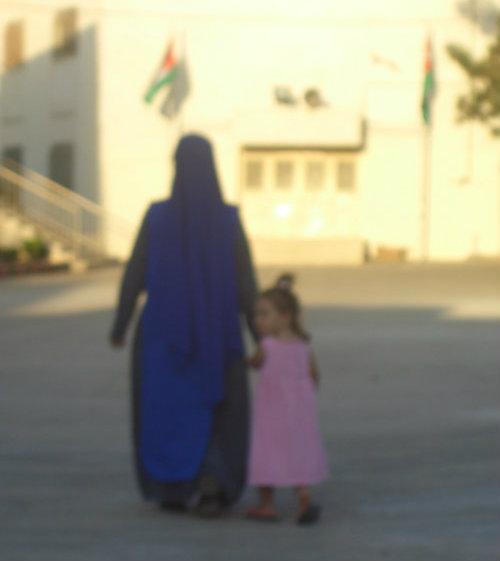Jordan tour: Borders, bagpipes, orphan girls
Our first full day in Jordan was spent mostly at sites of Greco-Roman ruins: we visited two cities of the ancient Decapolis, Gadara (now Umm Qais) and Gerasa (now Jerash). (Three of the ten if you count our initial home base in Amman, site of the ancient city of Philadelphia.) While Jesus is thought to have done ministry in both cities, the morning's main attractions were pagan ones.
On the way to Umm Qais, however, we stopped briefly to see the Zarqa River—the biblical Jabbok, where Jacob and Esau are reunited. It's a smallish, unimpressive bit of water, which makes all the more striking its Genesis role as a boundary the epically feuding siblings must cross to be reconciled. We stopped there when we did because it's on the way, but I don't imagine this theme of small but powerful boundaries between feuding people is lost on tour guides headed to Umm Qais.
 The city is biblically noteworthy for its claim on the synoptic account of the Gerasene demoniac, and its classical ruins are impressive. But the most striking thing is the international-border-rich vista: you can see the Sea of Galilee; the contested Golan Heights; the Israeli city of Tiberias; smaller villages in Jordan, Israel and Syria; and even a glimpse of Lebanon. (Also: towers with soldiers with guns.)
The city is biblically noteworthy for its claim on the synoptic account of the Gerasene demoniac, and its classical ruins are impressive. But the most striking thing is the international-border-rich vista: you can see the Sea of Galilee; the contested Golan Heights; the Israeli city of Tiberias; smaller villages in Jordan, Israel and Syria; and even a glimpse of Lebanon. (Also: towers with soldiers with guns.)
Jerash's classical ruins are more extensive, and many are quite well preserved. At the theater a Bedouin duo plays—quite regularly, judging from the image search I just did—on bagpipes and marching bass drum, emphasizing familiar tunes from (I gathered) whichever part of the world seems to be the majority among the gathered tourists at the moment. You could study the history of empire, or you could just go to an Arab-world theater built by the Greeks and expanded by the Romans and listen to Bedouins play Yankee Doodle on British instruments.
Later we visited Anjara, a mountaintop town where Jesus and his mother are said to have passed through. The shrine of Our Lady on the Mountain is there, as is a small Catholic home for orphans and destitute children. The orphanage takes children in, educates them and houses them till adulthood or till their families' means improve. Its children include Christians and Muslims, boys and—recently—girls.
A few school-aged girls were more than happy to interrupt their studying to chat and goof around. (The place is a regular stop for Christian tourists, and the kids seem glad but not remotely surprised to see visitors.) One particularly friendly 12-year-old told me she was the first girl to live there when she arrived eight years ago. "How old are you, Steve?" she asked. I'm 33. She replied, "33? I saw you and I said to myself, he is 32." Perhaps a well-rehearsed charm line, but she delivered it convincingly.
 I asked her what she wanted to do when she grew up. "Did you see Sister?" she asked. "The one in blue? I want to be a sister." I asked why. "Cause I've been here with them long, and I want to be like them."
I asked her what she wanted to do when she grew up. "Did you see Sister?" she asked. "The one in blue? I want to be a sister." I asked why. "Cause I've been here with them long, and I want to be like them."
There were a couple sisters, each in blue, but I knew which one she meant. She was outside with a much younger girl who had lived there since her second week of life. They were playing together, posing for pictures and giving us a very sweet glimpse of their relationship. Here they are to the right.
I'll post a couple more times before the tour's end. Nothing lengthy or at all ambitious, just highlights of what we've seen. So far it's a good trip.
Disclosure: The Jordan Tourism Board is covering most of the expenses for this trip, though it is not trying to tell us what to say/write/blog about it. Images: Some rights reserved by Steve Thorngate.






